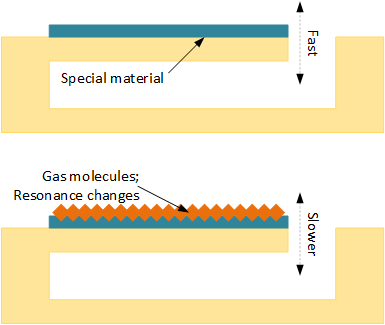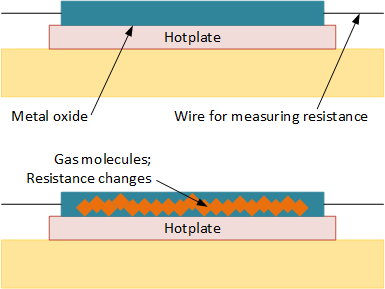
[From the last episode: We saw that adding a pressure sensor to our IMUsA combination sensor with an accelerometer and a gyroscope, and, often, with a magnetometer. The first two rely on inertia to tell you where you are and where you’re going. means we can navigate not only along roads and paths, but also up and down ramps, stairs, and elevators.]
OK, we’re going to take one final look at a different type of sensor – one that has nothing to do with navigation. It can be important for health and safety sensing, however. Today we look at gas sensorsA device that can measure something about its environment. Examples are movement, light, color, moisture, pressure, and many more.. You can think of them as electronic noses, although, unlike our (or, especially a dog’s) noses, most of them can smell only a few things – maybe only one.
There are plenty of gasses to be concerned about. In our homes, carbon monoxide (CO) is of particular concern. But there are plenty of other gasses that, in different situations, can be a problem, whether volatile organic compounds (VOCs), greenhouse gasses like CO2 and CH4 (methane), or radon in basements.
So how can we detect these materials in a miniature sensor? Well, as always – it depends. There are different approaches, and which one to use depends first on what you’re trying to detect. Then, the four key parameters are:
- How sensitive the detector is: how low a gas concentration can it detect?
- How selective the detector is: how well can it tell one gas from another?
- How fast the detector responds: how long do you have to wait to get a reading?
- How stable the detector is: does the reading change with temperature or humidity or over time?
Let’s take a look at how a couple of these work.
That Resonates with Me
One approach takes advantage of the fact that vibrations work differently for things with more or less mass. By resonate, I’m talking about the natural frequencyThe rate of change of a signal, specified in hertz, or cycles per second. that materials like to vibrate at. That frequency can vary for all kinds of reasons: material, size, temperature – you name it. A tuning fork is a good example. Or running a wet finger across the top of a wine glass. Those things vibrate at their resonant frequency. (You can get really deep into the concept, and you can get buried in the math… we won’t worry about that.)
So imagine, just for simplicity, the cantilever that we saw a while back. Basically, a super-micro-diving board. Like a real diving board, if you flick the end of it, it will vibrate at some speed. And, in the case of a MEMS version, you can measure what that frequency is.
So, yeah, I said that the frequency depends on all kinds of things. Let’s say that we control those things: we know what material we’re using and how big and heavy it is, and we control the environment like the temperature. Now we pretty well know what we expect that frequency to be.
So now let’s say that the surface of that cantilever has a special material on it. What kind? Well, something that can attract the gas we’re interested in detecting. If the gas shows up, it will absorb into or adsorb onto (a fancy way of saying, “stick to”) the cantilever. So now we have more molecules in or on the thing – which makes it heavier. Which changes the resonant frequency, making it slower. If you measure that frequency change, then you know you’ve detected the gas.

Showing MOXie
A second way of doing this is by using a metal oxideA substance created when oxygen binds to some other element. When that happens with iron, we get rust. When that happens with silicon, we get materials like sand and quartz. Often, the oxides of conductors and semiconductors will be insulators. (often abbreviated MOX). We can use different kinds, but tin oxide is common. A MOX has a natural high resistanceForces that tend to reduce the amount of flow or current. Measured in ohms (Ω). to electrical currentThe amount of electrical flow. Measured in amperes or amps (A)., but if it absorbs some other material in the form of a gas, then that resistance changes. Resistance is pretty straightforward to measure, so this gives us our signal.
It helps for this to happen at higher temperatures, so MEMS versions of these sensors literally have a micro-hotplate in them to heat up the MOX. That actually uses a bit of energy, but this is a common technique.

In both of these cases, the materials matter. Some materials might attract more than one gas, so when the measurement changes, you might not know which gas it is. If you make really sensitive measurements of resonance or resistance, then maybe you can tell one from another.
You also have to think about practical things. Like, after the gas sticks, how do you clean the sensor off again so that it can do another measurement? Or perhaps this is a one-time detector that you throw away after use.
Electronic Sniffing
This, like all sensors, is an area of pretty rapid development. So whatever we discuss today will likely change over the next few years. But the principles remain in place, so your understanding of today’s approaches will still serve you if you come back to this in the future, after these sensors have moved on.
But I wouldn’t be surprised to find air quality sensor in future phones, or more inexpensive radon detectors for your basement, or cheap, accurate personal breathalyzers that will keep you off the road when you shouldn’t be on the road.
And with that, we take our leave of sensors for the time being.

Leave a Reply